Article MT219
E J Moeran
Collecting folk songs in East Norfolk - in his own words
 Ernest John Moeran (1894-1950) was a prolific English composer, often regarded today as a rather neglected figure in Twentieth Century music. As with others of his generation, such as Vaughan Williams and Percy Grainger, much of his work was heavily influenced by the folk songs he experienced and collected in Norfolk and Suffolk and, later in life, in Ireland. As well as orchestral works inspired by these songs, he published two collections of his own arrangements of East Anglian folk songs - Six Norfolk Folk Songs in 1924 and Six Suffolk Folk Songs in 1932.
Ernest John Moeran (1894-1950) was a prolific English composer, often regarded today as a rather neglected figure in Twentieth Century music. As with others of his generation, such as Vaughan Williams and Percy Grainger, much of his work was heavily influenced by the folk songs he experienced and collected in Norfolk and Suffolk and, later in life, in Ireland. As well as orchestral works inspired by these songs, he published two collections of his own arrangements of East Anglian folk songs - Six Norfolk Folk Songs in 1924 and Six Suffolk Folk Songs in 1932.
Very early in his life, Moeran's family moved to Bacton, Norfolk 1 and it was here, in 1913, he collected his first folk songs, from William Mayes, senior member of the church choir, from whom he noted The Dark Eyed Sailor, and a few more from village inhabitants. The First World War put an end to this collecting temporarily, but Moeran resumed the activity afterwards, having been released from the Army, after having been badly wounded.
1 and it was here, in 1913, he collected his first folk songs, from William Mayes, senior member of the church choir, from whom he noted The Dark Eyed Sailor, and a few more from village inhabitants. The First World War put an end to this collecting temporarily, but Moeran resumed the activity afterwards, having been released from the Army, after having been badly wounded. 2 His most prolific period was from 1921 until 1924, mainly in Norfolk, including collecting songs from Harry Cox in 1922: being active in Sutton, Hickling, Potter Heigham and Catfield, all broads villages in East Norfolk, as well as a foray into Stonham, Suffolk, in 1921. This resulted in an estimated 150 songs collected across these four years, some of which were published in the Journal of the Folk Song Society, vol 7, in 1922.
2 His most prolific period was from 1921 until 1924, mainly in Norfolk, including collecting songs from Harry Cox in 1922: being active in Sutton, Hickling, Potter Heigham and Catfield, all broads villages in East Norfolk, as well as a foray into Stonham, Suffolk, in 1921. This resulted in an estimated 150 songs collected across these four years, some of which were published in the Journal of the Folk Song Society, vol 7, in 1922. 3
3
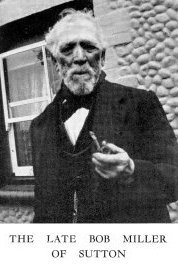 There was further collecting in the same area of Norfolk in 1926 and 1927, as well as in Coddenham, Suffolk, in 1931. Then as far as East Anglia was concerned, there was no further song collecting until Moeran arrived back in the area with BBC sound engineers to record more from Sutton Windmill in Norfolk and Eastbridge Eel's Foot in Suffolk in October, 1947, for a radio broadcast.
There was further collecting in the same area of Norfolk in 1926 and 1927, as well as in Coddenham, Suffolk, in 1931. Then as far as East Anglia was concerned, there was no further song collecting until Moeran arrived back in the area with BBC sound engineers to record more from Sutton Windmill in Norfolk and Eastbridge Eel's Foot in Suffolk in October, 1947, for a radio broadcast.
Prior to these last collecting trips, Moeran had written an article in July, 1946: Folk Songs and some Traditional Singers in East Anglia, which appeared in the autumn 1946 edition of the quarterly magazine Countrygoer. 4 In this, Moeran details his collecting in Norfolk, in particular from Bob 'Jolt' Miller from Sutton and Harry Cox from Catfield. Feeling that he had tapped a rich vein in the 1920s, he writes that 'I soon found out that the art of folk singing, in this corner of Norfolk at any rate, was still flourishing in the 1920s' but that (of 1946) 'It seems likely that the spontaneous singing of old songs when men foregather on Saturday nights has now died out.'
4 In this, Moeran details his collecting in Norfolk, in particular from Bob 'Jolt' Miller from Sutton and Harry Cox from Catfield. Feeling that he had tapped a rich vein in the 1920s, he writes that 'I soon found out that the art of folk singing, in this corner of Norfolk at any rate, was still flourishing in the 1920s' but that (of 1946) 'It seems likely that the spontaneous singing of old songs when men foregather on Saturday nights has now died out.'
This article is a useful insight into the observations of a well-informed outsider, who obviously got on very well with the local performers, and was able to coax a great deal of songs out of them. What does not seem to be known however, is that this 1946 article is based on - and a substantially rewritten version of - a piece Moeran wrote for the October 1936 edition of Norfolk Annual, ten years earlier, entitled Notes on Folk-Songs and Traditional Singing in East Norfolk. This earlier article contains more detailed information with regard to Moeran's collecting in East Norfolk in the 1920s, and is worth considering in detail here.
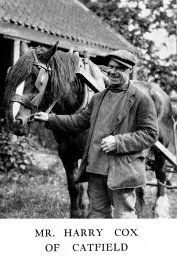 In the 1936 article, Moeran describes commencing his fruitful post-war collecting in East Norfolk thus: 'However, in the late summer of 1921, I received an urgent message from that folk-song enthusiast, Mr Arthur Batchelor, to come over to Sutton, near Stalham. It appeared that he had accidentally overheard an old roadman singing softly to himself over his work. This turned out to be none other than the late Bob Miller, known for miles around, I have never discovered why, as 'Jolt'.'
In the 1936 article, Moeran describes commencing his fruitful post-war collecting in East Norfolk thus: 'However, in the late summer of 1921, I received an urgent message from that folk-song enthusiast, Mr Arthur Batchelor, to come over to Sutton, near Stalham. It appeared that he had accidentally overheard an old roadman singing softly to himself over his work. This turned out to be none other than the late Bob Miller, known for miles around, I have never discovered why, as 'Jolt'.'
Bob admitted he knew some "old uns," but he was at pains to point out that he had not really been singing, but "just a-tuning over to himself." I soon fixed an appointment to spend the ensuing evening in his company at a local inn, and he gave me a splendid batch of songs, some of which were hitherto unpublished. Moreover, by his enthusiasm and personality, he opened the way to a series of convivial evenings at which I found that the art of folk-singing, given a little encouragement, had by no means died out.'
And by such means, Moeran met Harry Cox, who seems to have impressed him immediately: 'About the third occasion on which I was present at one of these entertainments, Bob greeted me with the introduction, "Here's Harry have come to sing to you tonight." He had succeeded in enlisting the interest of Harry Cox of Catfield, probably unique in England to-day as a genuine traditional singer combining comparative youth with a style of artistry which has almost disappeared. He has an enormous repertory of old songs, most of which have been handed down through his family. The Coxs have been known for generations as singers and musicians. Harry is gifted with an extraordinary memory; he is capable of hearing, on no more than three or four separate occasions, a song of a dozen verses, and remembering it permanently. The year before last he was chosen by the English Folk Dance and Song Society to make official gramophone records of traditional songs. In spite of this occasion, which also constituted his first visit to London, the ordeal of recording at the Decca company's studio passed off without a hitch. 5 A famous baritone who was present was so impressed that an immediate audition was arranged at the BBC, with the result that Harry Cox received an engagement to broadcast a recital of Norfolk songs in the Foundations of Music series.'
5 A famous baritone who was present was so impressed that an immediate audition was arranged at the BBC, with the result that Harry Cox received an engagement to broadcast a recital of Norfolk songs in the Foundations of Music series.' 6
6
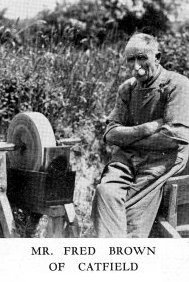 Moeran obviously got on well with these men, who were by no means put off by his noting down their songs in his notebook; in fact, quite the opposite: 'The sing-songs which I heard as a result of my meeting with Messrs Miller and Cox led to opportunities of knowing many other singers and hearing them perform. It also led to a friendly rivalry on the part of some of them as to who could contribute the most to my collection. One evening, a song was in progress, one that I knew well and therefore was not troubling to note. Half-way through, the singer stopped dead. Cries of encouragement from the company: "Go you on, Bob," to which came the reply, "No, I ain't a-goin' on; he ain't a-writin' on it down in his book." Naturally I heard quantities of oldish ditties that were by no means traditional, but which mostly dated from the Victorian ballad epoch. Perhaps the most startling appearance of a non-folk-song was when a greybeard wearing earrings announced that he was about to oblige the company. Turning to me he said: "This is a rare old 'un; I'll lay you haint heard it afore." I was somewhat non-plussed when the song turned out to be Rule, Britannia, and even more so when the whole taproom solemnly sat it out and joined in the chorus.'
Moeran obviously got on well with these men, who were by no means put off by his noting down their songs in his notebook; in fact, quite the opposite: 'The sing-songs which I heard as a result of my meeting with Messrs Miller and Cox led to opportunities of knowing many other singers and hearing them perform. It also led to a friendly rivalry on the part of some of them as to who could contribute the most to my collection. One evening, a song was in progress, one that I knew well and therefore was not troubling to note. Half-way through, the singer stopped dead. Cries of encouragement from the company: "Go you on, Bob," to which came the reply, "No, I ain't a-goin' on; he ain't a-writin' on it down in his book." Naturally I heard quantities of oldish ditties that were by no means traditional, but which mostly dated from the Victorian ballad epoch. Perhaps the most startling appearance of a non-folk-song was when a greybeard wearing earrings announced that he was about to oblige the company. Turning to me he said: "This is a rare old 'un; I'll lay you haint heard it afore." I was somewhat non-plussed when the song turned out to be Rule, Britannia, and even more so when the whole taproom solemnly sat it out and joined in the chorus.'
There follows a reflection on the origin of these old songs: 'As for the actual folk-songs, it is difficult to single out many of them as being exclusively Norfolk; English folk-song in the main has been common property all over the country. At the same time, there are a few of them that certainly have not been noted away from Norfolk, but it is a great mistake to assume, as writers on local lore frequently have done, that every traditional song one has heard at a Harvest Home or in a public house, is necessarily of specifically Norfolk origin. A good example of an East Coast local song is one associated with the fishing fleet, with its chorus, 'From the Dogger Bank to Great Grimsbee.'
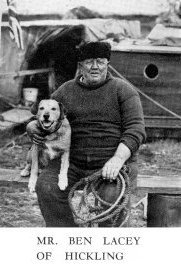 I have known of its existence for several years, but only recently have I succeeded in hunting it down in a complete version. Mr Fred Brown, now living on Catfield Common, has supplied it. It is said to be of almost contemporary origin but, to my mind, it is not thereby prevented from being classed as a folk-song.'
I have known of its existence for several years, but only recently have I succeeded in hunting it down in a complete version. Mr Fred Brown, now living on Catfield Common, has supplied it. It is said to be of almost contemporary origin but, to my mind, it is not thereby prevented from being classed as a folk-song.' 7
7
In this earlier article, Moeran's statement about the dying out of traditional singing is somewhat qualified: 'It seems likely that the spontaneous singing of old songs when men meet together on Saturday nights no longer exists, save in districts where there is a considerable sprinkling of those who have followed the herring. It has been customary to sing at sea, and one can visit many an inn within easy reach of Great Yarmouth where, even now, it is sometimes possible to while away a winter's evening with an impromptu concert of traditional songs. Travel further along the coast, and you will hear little of the kind. It used to be the boast of the late Bob Cox, Harry's father, that he would do a herring fishing season, sing two songs every night, and never repeat himself. Such was his repertory; it is to my lasting regret that I did not make his acquaintance until he was too old to be induced to sing. These songs are not necessarily those dealing with the perils of the deep. There are sea-songs of another type, common among sailors who have travelled the world. A good exponent of this variety is Mr Ben Lacey of Hickling.' 8
8
To sum up, Moeran was at pains to show exactly what he was looking for in his hunt for folk songs in East Norfolk: 'In these notes I have not been concerned with the activities of those who are attempting to bring about a revival of folk-singing artificially. In other words, by stimulating an interest in the art by means of teaching folk-songs in schools, or the organizing of garden fetes, etc. at which hashed up and watered down folk-songs are performed in the sophisticated manner of those who have never heard a traditional singer.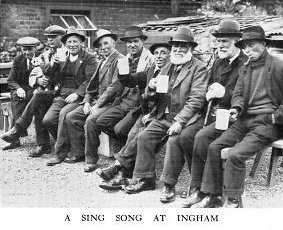 Laudable as all this is, it is something quite apart from the art of those who have it in their very bones, handed down from father to son. For one thing, the surroundings and 'atmosphere' are wrong. It may as well be stated emphatically that genuine traditional singing is non-existent apart from beer. Also, that owing to legal expediency, practically every published collection of English folk-songs bears just about the same relationship to the genuine article as does Mr Bowdler's version to the authentic Shakespeare.
Laudable as all this is, it is something quite apart from the art of those who have it in their very bones, handed down from father to son. For one thing, the surroundings and 'atmosphere' are wrong. It may as well be stated emphatically that genuine traditional singing is non-existent apart from beer. Also, that owing to legal expediency, practically every published collection of English folk-songs bears just about the same relationship to the genuine article as does Mr Bowdler's version to the authentic Shakespeare.
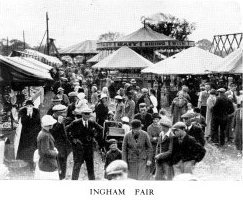 Real folk-singing, however, still goes on in isolated places amongst the people of East Norfolk and, given encouragement, may possibly continue to do so for a time. Any convivial event or 'frolic', such as the annual fair held at Ingham, provides the excuse for songs to burst forth, and there is no more stimulating experience than to sit among the company, and to be privileged to join in the chorus of such a fine heritage of Old English song as inevitably comes back to light on these occasions.'
Real folk-singing, however, still goes on in isolated places amongst the people of East Norfolk and, given encouragement, may possibly continue to do so for a time. Any convivial event or 'frolic', such as the annual fair held at Ingham, provides the excuse for songs to burst forth, and there is no more stimulating experience than to sit among the company, and to be privileged to join in the chorus of such a fine heritage of Old English song as inevitably comes back to light on these occasions.'
This article detailing Moeran's collecting in the 1920s was his last involvement in the collecting of local folk song until he re-wrote it in 1946. By this time, he was spending little time in the area, apart from the occasional holiday. On his return in October 1947 to record for the BBC, he was delighted to find many of his old friends still alive and performing. The resulting fifty-minute programme East Anglia Sings was made up of songs from Eastbridge Eel's Foot and Sutton Windmill and was broadcast on the BBC Third Programme on Wednesday 19th November 1947. 9 It comprised the following performances:
9 It comprised the following performances:
The nine songs from the Norfolk singers (just a couple of verses each, in MP3 format) can be heard by clicking on the highlighted song title in the above table. Also, our friends from Snatch'd From Oblivion records have made the entire 51 minutes of the late 1947 Third Programme broadcast, East Anglia Sings available on CD SFO 005, which can be bought from Musical Traditions Records, priced just £5.00.
In the introduction to the Windmill part of the programme, Moeran and another presenter, Martin Boddy, prefaced the songs thus:
Boddy: "We drove on northwards through Yarmouth, with its river packed with the herring fleet, to the Broads country, an area which must be unmatched for its songs and singers, an area in which E J Moeran has collected songs for over twenty five years."
Moeran: "Yes, it was in 1921 that I first met Bob Miller near Stalham in Norfolk, a near relation of a singer you'll hear tonight. He, in turn, introduced me to that prince of singers, Harry Cox. He, as you will hear, presents his songs with a true artistry and a style that has almost disappeared. We worked in The Windmill, an inn on the main road. Nothing could tell you from its very ordinary exterior that within it were gathered folk song singers from the nearby countryside. They were all old friends: Harry Cox, Charlie Chettleburgh, John Salmons, Elijah Bell, Walter Gales and Billy Miller. Together they could sing for weeks on end. But I'm afraid tonight you can hear but a few of their lovely songs."
This broadcast was to be Moeran's last involvement with traditional song in East Anglia. Returning to Ireland, where he had spent much time in the last decade, he was seen to fall off Kenmare Pier in the afternoon of 1st December, 1950, and was dead when pulled out of the water. A post mortem examination found that he had died of a cerebral haemorrhage before falling into the water.
Chris Holderness - 9.01.09
Rig-a-Jig-Jig: A Norfolk Music History Project
Notes:
1. For much detailed information about Moeran's life and works, see the International Moeran Database: www.moeran.com
2. Moeran was badly wounded in the head by shrapnel at Bellecourt, France in 1917.
3. Much detailed information about Harry Cox, including meeting Moeran, can be found in Paul Marsh's booklet notes to Topic CD: Harry Cox: The Bonny Labouring Boy TSCD512D. Thanks to Paul Marsh for information relating to this article.
4. This article has been republished in full at www.moeran.com as above.
5. The two songs released were The Pretty Ploughboy and The Bold Fisherman, now available on Vols 1 and 2 of Topic's Voice of the People series: TSCD651 and TSCD652.
6. As far as I have been able to find out, nothing seems to have come of this audition.
7. For a local sound recording, see Winterton fisherman Sam Larner singing The Dogger Bank on Topic CD Now is the Time for Fishing TSCD511.
8. Unfortunately, Moeran gives no further information about exactly what type of songs he means, nor any examples.
9. The Suffolk part of the programme is available as part of Veteran CD Good Order! VT140CD.
All photographs used in the article, apart from that of Moeran himself, accompanied the original 1936 article in Norfolk Annual.
Article MT219
Site designed and maintained by Musical Traditions Web Services Updated: 20.1.09
 Ernest John Moeran (1894-1950) was a prolific English composer, often regarded today as a rather neglected figure in Twentieth Century music. As with others of his generation, such as Vaughan Williams and Percy Grainger, much of his work was heavily influenced by the folk songs he experienced and collected in Norfolk and Suffolk and, later in life, in Ireland. As well as orchestral works inspired by these songs, he published two collections of his own arrangements of East Anglian folk songs - Six Norfolk Folk Songs in 1924 and Six Suffolk Folk Songs in 1932.
Ernest John Moeran (1894-1950) was a prolific English composer, often regarded today as a rather neglected figure in Twentieth Century music. As with others of his generation, such as Vaughan Williams and Percy Grainger, much of his work was heavily influenced by the folk songs he experienced and collected in Norfolk and Suffolk and, later in life, in Ireland. As well as orchestral works inspired by these songs, he published two collections of his own arrangements of East Anglian folk songs - Six Norfolk Folk Songs in 1924 and Six Suffolk Folk Songs in 1932.
 There was further collecting in the same area of Norfolk in 1926 and 1927, as well as in Coddenham, Suffolk, in 1931. Then as far as East Anglia was concerned, there was no further song collecting until Moeran arrived back in the area with BBC sound engineers to record more from Sutton Windmill in Norfolk and Eastbridge Eel's Foot in Suffolk in October, 1947, for a radio broadcast.
There was further collecting in the same area of Norfolk in 1926 and 1927, as well as in Coddenham, Suffolk, in 1931. Then as far as East Anglia was concerned, there was no further song collecting until Moeran arrived back in the area with BBC sound engineers to record more from Sutton Windmill in Norfolk and Eastbridge Eel's Foot in Suffolk in October, 1947, for a radio broadcast.
 In the 1936 article, Moeran describes commencing his fruitful post-war collecting in East Norfolk thus: 'However, in the late summer of 1921, I received an urgent message from that folk-song enthusiast, Mr Arthur Batchelor, to come over to Sutton, near Stalham. It appeared that he had accidentally overheard an old roadman singing softly to himself over his work. This turned out to be none other than the late Bob Miller, known for miles around, I have never discovered why, as 'Jolt'.'
In the 1936 article, Moeran describes commencing his fruitful post-war collecting in East Norfolk thus: 'However, in the late summer of 1921, I received an urgent message from that folk-song enthusiast, Mr Arthur Batchelor, to come over to Sutton, near Stalham. It appeared that he had accidentally overheard an old roadman singing softly to himself over his work. This turned out to be none other than the late Bob Miller, known for miles around, I have never discovered why, as 'Jolt'.'
 Moeran obviously got on well with these men, who were by no means put off by his noting down their songs in his notebook; in fact, quite the opposite: 'The sing-songs which I heard as a result of my meeting with Messrs Miller and Cox led to opportunities of knowing many other singers and hearing them perform. It also led to a friendly rivalry on the part of some of them as to who could contribute the most to my collection. One evening, a song was in progress, one that I knew well and therefore was not troubling to note. Half-way through, the singer stopped dead. Cries of encouragement from the company: "Go you on, Bob," to which came the reply, "No, I ain't a-goin' on; he ain't a-writin' on it down in his book." Naturally I heard quantities of oldish ditties that were by no means traditional, but which mostly dated from the Victorian ballad epoch. Perhaps the most startling appearance of a non-folk-song was when a greybeard wearing earrings announced that he was about to oblige the company. Turning to me he said: "This is a rare old 'un; I'll lay you haint heard it afore." I was somewhat non-plussed when the song turned out to be Rule, Britannia, and even more so when the whole taproom solemnly sat it out and joined in the chorus.'
Moeran obviously got on well with these men, who were by no means put off by his noting down their songs in his notebook; in fact, quite the opposite: 'The sing-songs which I heard as a result of my meeting with Messrs Miller and Cox led to opportunities of knowing many other singers and hearing them perform. It also led to a friendly rivalry on the part of some of them as to who could contribute the most to my collection. One evening, a song was in progress, one that I knew well and therefore was not troubling to note. Half-way through, the singer stopped dead. Cries of encouragement from the company: "Go you on, Bob," to which came the reply, "No, I ain't a-goin' on; he ain't a-writin' on it down in his book." Naturally I heard quantities of oldish ditties that were by no means traditional, but which mostly dated from the Victorian ballad epoch. Perhaps the most startling appearance of a non-folk-song was when a greybeard wearing earrings announced that he was about to oblige the company. Turning to me he said: "This is a rare old 'un; I'll lay you haint heard it afore." I was somewhat non-plussed when the song turned out to be Rule, Britannia, and even more so when the whole taproom solemnly sat it out and joined in the chorus.'
 I have known of its existence for several years, but only recently have I succeeded in hunting it down in a complete version. Mr Fred Brown, now living on Catfield Common, has supplied it. It is said to be of almost contemporary origin but, to my mind, it is not thereby prevented from being classed as a folk-song.'
I have known of its existence for several years, but only recently have I succeeded in hunting it down in a complete version. Mr Fred Brown, now living on Catfield Common, has supplied it. It is said to be of almost contemporary origin but, to my mind, it is not thereby prevented from being classed as a folk-song.' Laudable as all this is, it is something quite apart from the art of those who have it in their very bones, handed down from father to son. For one thing, the surroundings and 'atmosphere' are wrong. It may as well be stated emphatically that genuine traditional singing is non-existent apart from beer. Also, that owing to legal expediency, practically every published collection of English folk-songs bears just about the same relationship to the genuine article as does Mr Bowdler's version to the authentic Shakespeare.
Laudable as all this is, it is something quite apart from the art of those who have it in their very bones, handed down from father to son. For one thing, the surroundings and 'atmosphere' are wrong. It may as well be stated emphatically that genuine traditional singing is non-existent apart from beer. Also, that owing to legal expediency, practically every published collection of English folk-songs bears just about the same relationship to the genuine article as does Mr Bowdler's version to the authentic Shakespeare.
 Real folk-singing, however, still goes on in isolated places amongst the people of East Norfolk and, given encouragement, may possibly continue to do so for a time. Any convivial event or 'frolic', such as the annual fair held at Ingham, provides the excuse for songs to burst forth, and there is no more stimulating experience than to sit among the company, and to be privileged to join in the chorus of such a fine heritage of Old English song as inevitably comes back to light on these occasions.'
Real folk-singing, however, still goes on in isolated places amongst the people of East Norfolk and, given encouragement, may possibly continue to do so for a time. Any convivial event or 'frolic', such as the annual fair held at Ingham, provides the excuse for songs to burst forth, and there is no more stimulating experience than to sit among the company, and to be privileged to join in the chorus of such a fine heritage of Old English song as inevitably comes back to light on these occasions.'